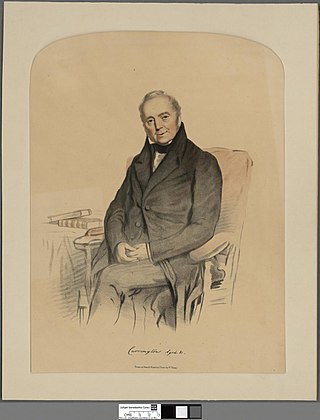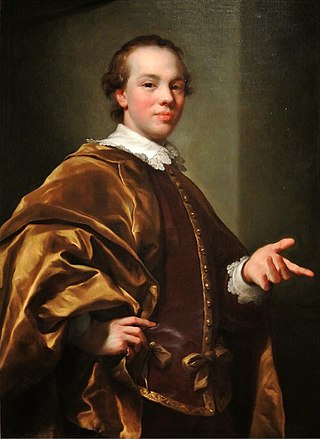Arms
 |
|
Baron Bateman, of Shobdon in the County of Hereford, was a title in the Peerage of the United Kingdom. It was created on 30 January 1837 for William Bateman, previously member of Parliament for Northampton. [1] Born William Hanbury, he was the grandson of William Hanbury and Sarah, daughter of William Western and Anne, sister of William Bateman, 1st Viscount Bateman (a title which became extinct in 1802). Lord Bateman was succeeded by his eldest son, the second Baron. He held minor political office and served as Lord-Lieutenant of Herefordshire for many years. The title became extinct on the death of his childless son, the third Baron, in 1931.
Charles Bateman-Hanbury-Kincaid-Lennox, younger son of the first Baron, was a politician.
 |
|

Earl of Listowel is a title in the Peerage of Ireland. It was created in 1822 for William Hare, 1st Viscount Ennismore and Listowel, who had earlier represented Cork City and Athy in the Irish House of Commons.

Earl of Effingham, in the County of Surrey, is a title in the Peerage of the United Kingdom, created in 1837 for Kenneth Howard, 11th Baron Howard of Effingham, named after the village of Effingham, Surrey, where heads of the family owned the manor.

Earl of Strafford is a title that has been created three times in English and British history.

Viscount Charlemont is a title in the Peerage of Ireland. It was created in 1665 for William Caulfeild, 5th Baron Charlemont.

Viscount Knollys, of Caversham in the County of Oxford, is a title in the Peerage of the United Kingdom. It was created in 1911 for the court official Francis Knollys, 1st Baron Knollys, Private Secretary to the Sovereign from 1901 to 1913. He had been previously created Baron Knollys, of Caversham in the County of Oxford, on 21 July 1902. His son, the second Viscount, served as Governor of Bermuda. As of 2023 the titles are held by the latter's grandson, the fourth Viscount, who succeeded in 2023. The third Viscountess Knollys was a sister of Baron Farnham: she served as Vice Lord-Lieutenant of Norfolk.
Viscount Camrose, of Hackwood Park in the County of Hampshire, is a title in the Peerage of the United Kingdom. It was created on 20 January 1941 for the prominent newspaper magnate William Berry, 1st Baron Camrose. He had previously received the award of Baronet, of Long Cross in the County of Surrey, in the Baronetage of the United Kingdom, on 4 July 1921, and was created Baron Camrose, of Long Cross in the County of Surrey, on 19 June 1929, in the Peerage of the United Kingdom. His second son, the third Viscount, disclaimed the peerages in 1995 on succeeding his elder brother. However, he had already been created a life peer as Baron Hartwell, of Peterborough Court in the City of London, on 19 January 1968. On his death in 2001 the life peerage became extinct while he was succeeded in the other titles by his eldest son, the fourth Viscount. The first three Viscounts all headed The Daily Telegraph at one point, the first having purchased it from Harry Levy-Lawson, 1st Viscount Burnham, but in the 1980s they lost control to Conrad Black.

Baron Carrington is a title that has been created three times, once in the Peerage of England, once in the Peerage of Ireland and once in the Peerage of Great Britain.

Baron Farnham, of Farnham in the County of Cavan, is a title in the Peerage of Ireland. It was created in 1756 for John Maxwell, who had previously represented Cavan Borough in the Irish House of Commons. John Maxwell's son, the second Baron, was created Viscount Farnham in 1760 and Earl of Farnham in 1763. Both titles were in the Peerage of Ireland but became extinct when he died childless in 1779. His brother and successor, the third Baron, was again created Viscount Farnham in 1781 and Earl of Farnham in 1785. These titles were also in the Peerage of Ireland. His son, the second Earl, sat in the House of Lords as an Irish Representative Peer from 1816 to 1823. However, he had no children and on his death in 1823 the viscountcy and earldom became extinct.

Baron Sudeley is a hereditary title that has been created three times in the history of Britain, twice in the Peerage of England and once in the Peerage of the United Kingdom. The first creation came in the Peerage of England in 1299 when John de Sudeley was summoned to Parliament as Lord Sudeley. On the death of the third Baron in 1367 the title fell into abeyance. The abeyance was terminated in 1380 when Thomas Boteler, the fourth Baron, became the sole heir. The sixth Baron was created Baron Sudeley by letters patent in 1441. He served as Lord High Treasurer from 1444 to 1447. On his death in 1473, the 1441 creation became extinct while the 1299 creation once again fell into abeyance.

Baron Burton, of Burton-on-Trent and of Rangemore in the County of Stafford, is a title in the Peerage of the United Kingdom. It was created in 1897 for the prominent brewer, philanthropist and Liberal politician Michael Bass, 1st Baron Burton. He had already been created a baronet in 1882 and Baron Burton in 1886. However, the three titles had different remainders. The Bass family descended from William Bass, who founded the brewery business of Bass & Co in Burton upon Trent in 1777. His grandson Michael Thomas Bass transformed the company into one of the largest breweries in the United Kingdom. He also represented Derby in Parliament as a Liberal for thirty-five years and was a great benefactor to the town of Burton. However, Bass declined every honour offered to him, including a baronetcy and a peerage.

Baron Burnham, of Hall Barn in the Parish of Beaconsfield in the County of Buckingham, is a title in the Peerage of the United Kingdom. It was created on 31 July 1903 for the influential newspaper magnate Sir Edward Levy-Lawson, 1st Baronet, owner of The Daily Telegraph. He had already been created a Baronet, of Hall Barn in The Parish of Beaconsfield in the County of Buckingham and of Peterborough Court in the City of London, in the Baronetage of the United Kingdom on 13 October 1892. Levy-Lawson was the son of Joseph Moses Levy, who acquired The Daily Telegraph only months after its founding.

Lord Sherard, Baron of Leitrim, was a title in the Peerage of Ireland in 1627. The third holder of the barony would also be named Baron Harborough (1714), Viscount Sherard (1718), and Earl of Harborough (1719), with the viscountcy ending with the death of its original holder in 1732, but the other titles persisting in the family until 1859. The Sherard barony became dormant in 1931 with the death of the last known male-line family member.
Viscount Bateman was a title in the Peerage of Ireland. It was created on 12 July 1725 for William Bateman, previously Member of Parliament for Leominster and the son of Sir James Bateman, Lord Mayor of London from 1716 to 1717. He was made Baron Culmore, in the County of Londonderry, at the same time, also in the Peerage of Ireland. He was succeeded by his son, the second Viscount. He was also a politician and notably served as Treasurer of the Household between 1756 and 1757 and as Master of the Buckhounds between 1757 and 1782. He was childless and the titles became extinct on his death in 1802. As both the barony and viscountcy were Irish peerages, the holders sat in the House of Commons while holding the title.

Baron Wentworth is a title in the Peerage of England. It was created in 1529 for Thomas Wentworth, who was also de jure sixth Baron le Despencer of the 1387 creation. The title was created by writ, which means that it can descend via female lines.

William Bateman Bateman-Hanbury, 2nd Baron Bateman, styled The Honourable from 1837 until 1845, was a British peer and Conservative politician.

John Stewart, 7th Earl of Galloway,, styled Viscount Garlies from 1747 until 1773, was a British peer who became the 7th Earl of Galloway in 1773 and served as a Member of Parliament from 1761 to 1773.
George Rushout, 3rd Baron Northwick, was a British Conservative politician.

William Bateman-Hanbury, 1st Baron Bateman of Shobdon was a Member of Parliament and later a Baron in the Peerage of the United Kingdom.

John Bateman, 2nd Viscount Bateman was a British politician who sat in the House of Commons from 1746 to 1784.

Shobdon Court was an 18th-century English country house in the village of Shobdon, near Leominster, Herefordshire. Although the main house has since been demolished, the service wing and the stable block have been converted to residential use.